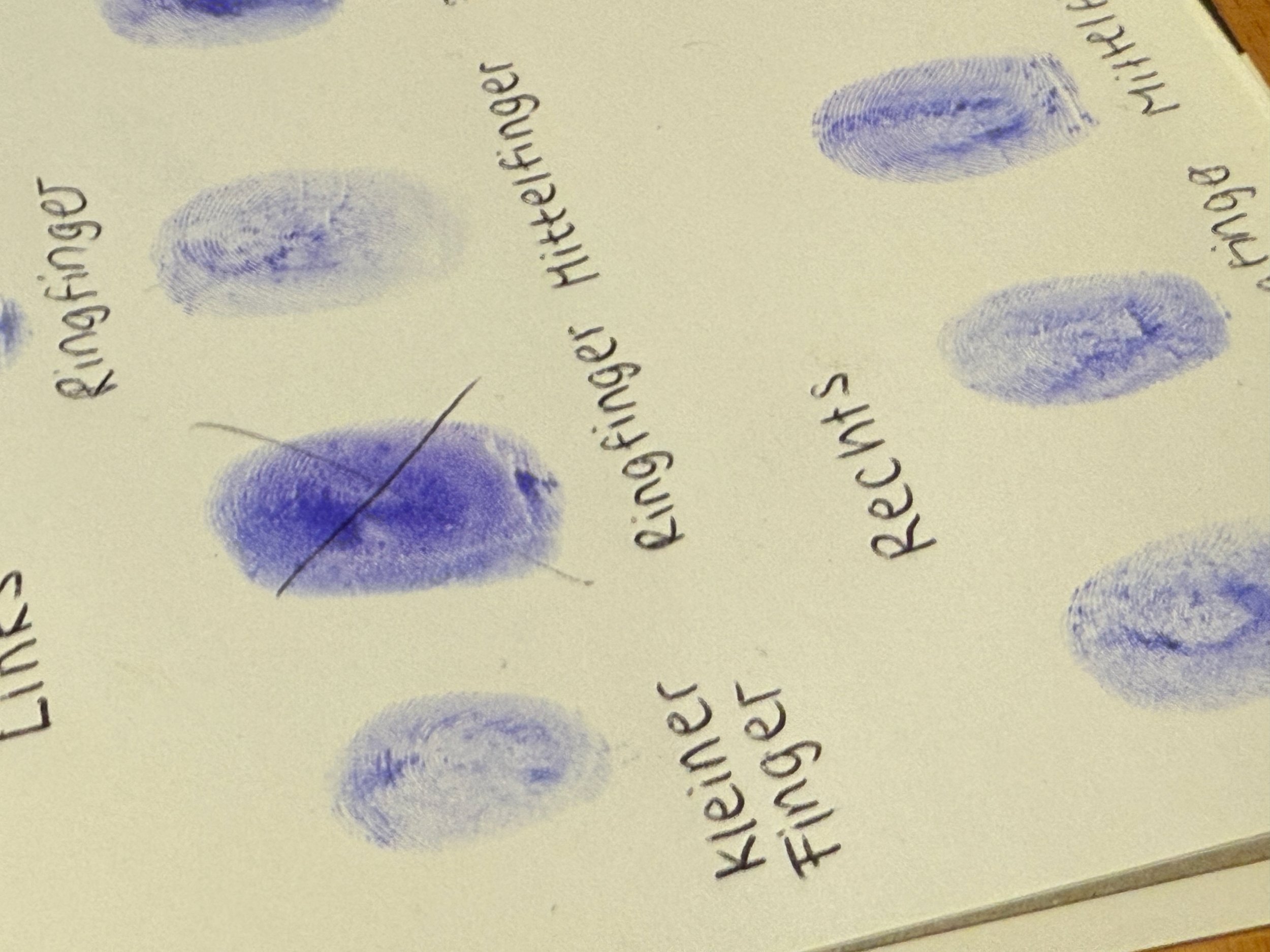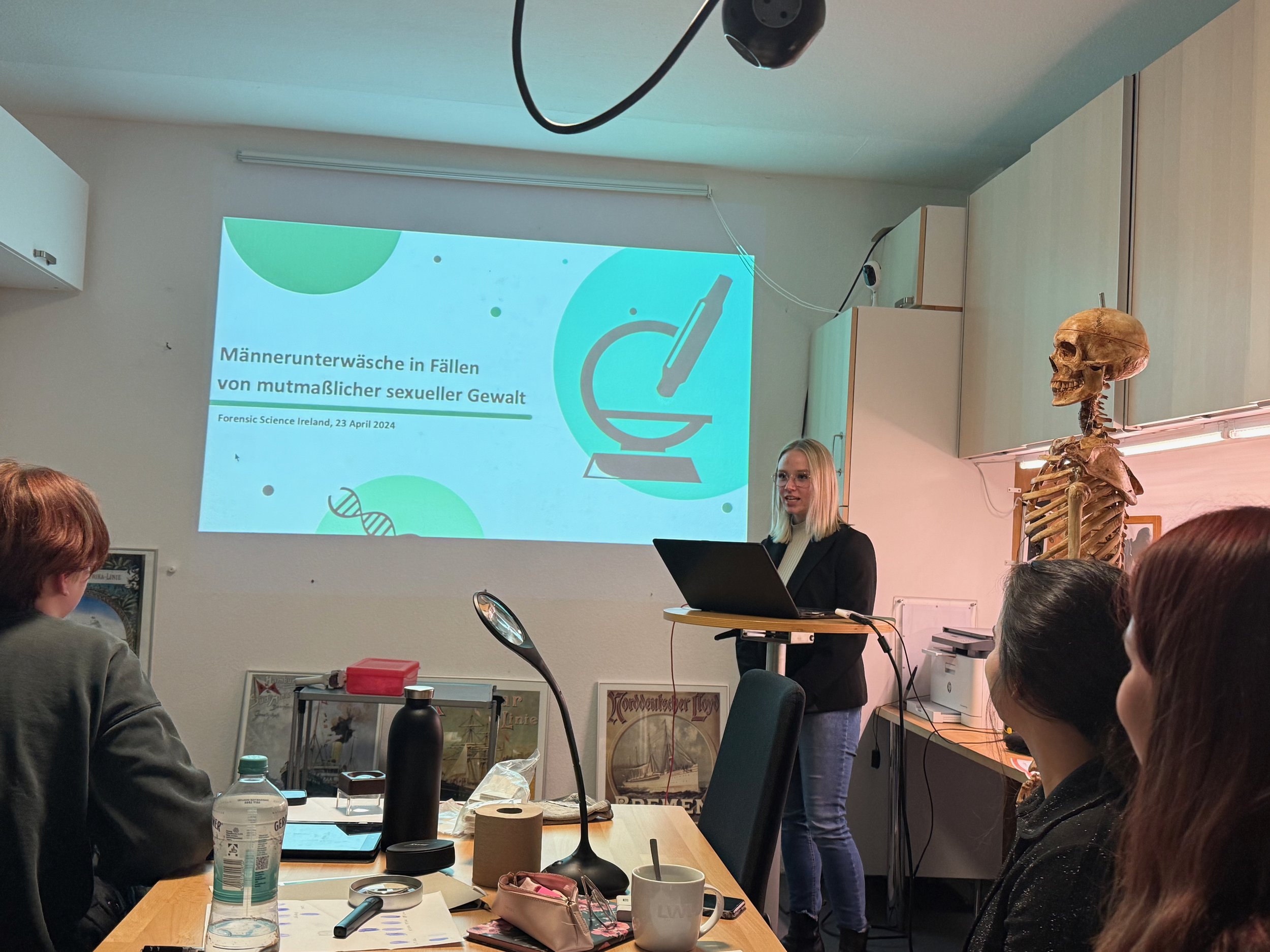Datum: 11. März 2008
Uhrzeit: 18.30 bis 19.00 Uhr
Ort: Aula am Aasee, Münster
Beteiligte Personen:
Dr. Mark Benecke Kriminalbiologe, Köln
Daniela Eschkotte Redakteurin Antenne Münster, Münster
Felix Altenbach Schüler der Ludgerusschule Münster-Hiltrup, Klasse 4a
Marcel Sablotny Lehramtsstudent im Forder-Förder-Projekt zur Begabtenförderung im Drehtürmodell (Praktikum ICBF, VVWU Münster, Ludgerusschule)
Experteninterview, durchgeführt im Rahmen des Forder-Förder-Projektes
Wissenschaftliche Begleitung: Prof. Dr. Christian Fischer
Internationales Centrum für Begabungsforschung an der Westfälischen Wilhelms-Universität Münster
Schule: Ludgerusschule Münster-Hiltrup
Schulleiterin: Gabriele Langkamp
Stellvertretender Schulleiter: Martin Nielebock
Klassenlehrerinnen: Claudia Sander-Braunert, Maria Kerkmann, Claudia Thies
Projektleiterin: Monika Kaiser-Haas
Studierende: Marcel Sablotny, Daniel Bublitz, Nadine Wrocklage, Andreas Micke, Antje Depping
Von Felix Altenbach
Frage: Wie viel Prozent der Kriminalfälle können durch solche Untersuchungen endgültig geklärt werden?
Antwort: Endgültig ... , na ja, was endgültig ist, entscheidet der Richter. Ich würd' mal sagen, durch genetische Fingerabdrücke kannst Du viel mehr Fälle als früher sehr schnell lösen.
Und insgesamt?
Durch alle forensischen und kriminalbiologischen Untersuchungen? So viel man weiß, bei Tötungsdelikten, also bei Mord und Totschlag und so werden dadurch angeblich 95 % der Fälle gelöst. Aber wir wissen ja gar nicht, wie viele Fälle wir gar nicht erst entdecken; das heißt, die sogenannte Dunkelziffer. Wir glauben, dass wir 95 % der Fälle lösen, aber in Wirklichkeit sind es viel weniger, weil wir nicht die anderen Fälle haben.
Kann es sein, dass es dann nur 50 % der Fälle sind?
Ja, könnte sein. Aber ich glaub', es sind nicht ganz so viele, weil manchmal entdeckt man ja zufällig ein Verbrechen und dann stellt man fest, dass da nur irgendetwas Bestimmtes übersehen wurde. Aber es kann sein. Ich halt's nicht für sehr wahrscheinlich, aber möglich ist es, ja.
Was ist eine forensische Untersuchung?
Forensische Untersuchung ist alles, was man vor Gericht macht. Es gab früher bei den Griechen ein Scherbengericht. Da haben sich alle Leute auf den Marktplatz gestellt und da wurde dann eine Gerichtsverhandlung gemacht. Auf dem Forum, dem Marktplatz. In foro = vor der Öffentlichkeit. Und dann haben die in die Scherben geritzt, ob sie geglaubt haben, ob derjenige schuldig ist oder nicht. Also Gerichtsverhandlungen sind theoretisch öffentlich, also wenn man nicht arbeiten müsste - die meisten müssen zwar arbeiten - und Zeit hätte, könnte man dahin gehen. Gut.
Jede Untersuchung, die einen Sachbeweis darstellt, ist dann forensisch. Das heißt, wenn ein Arzt zum Beispiel sagt, diese Verletzung kommt von einem Messer, dann ist das forensisch. Oder wenn ein Giftkundler sagt, man kriegt nur ein blaue Zunge von dem und dem Gift. Oder ich als Kriminalbiologe sage zum Beispiel, das Tier da lebt normalerweise nur in einem Mangofeld. Jetzt haben wir die Leiche aber im Wasser gefunden, da wachsen aber keine Mangos. So was. Also alles, was Expertenwissen darstellt.
Es gibt auch andere Fälle, wie ein Techniker. Oder hier, Tätowierer. Mein Tätowierer war mal ein forensischer Tätowierer, weil er vor Gericht sagen musste, wie schlecht das Tattoo von dem Mann ist, der gesagt hat: Mein Tattoo ist so schlecht, ich will jetzt Schmerzensgeld oder so was dafür. Oder Du, Du hast ja Lehrer. Dann könnte man Dich als Experten befragen und sagen: Findest Du, dass Deine Lehrer nett sind oder nicht nett sind, oder, ob die was können oder nicht können. Dann bist du auch ein Experte, nicht forensisch, aber Experte bist Du dann.
Gibt es eigentlich viele Lehrlinge in Ihrem Beruf, also Menschen, die das lernen?
Ja, wir haben ganz viele Studenten. Ja, wir machen auf der ganzen Welt Kurse und dann sind das Studenten. Übrigens, das mit dem "Lehrling" ist auch eine gute Frage. Wir sagen auch, das ist wie ,Lehrlingsein' und später, wenn Du das ein bisschen kannst, ist das wie beim Gesellen im Handwerk. Und wenn Du das richtig lange machst, bist Du ein Meister, wie zum Beispiel ein Bäckermeister oder ein Fliesenlegermeister oder so was. Da muss man es aber länger machen und mehr Erfahrung haben.
Welche Methoden zur Aufklärung eines Verbrechens sind in letzter Zeit neu hinzugekommen?
Also 1985 - was für mich eine kurze Zeit und für Dich 'ne lange Zeit ist - sind die genetischen Fingerabdrücke erfunden worden. Das war eine sehr neue Methode. Und jetzt, in allerneuester Zeit gibt's noch so Spezialmethoden, wo alles viel schneller geht. Das, was sonst ein Mensch machen musste und ganz lange dauerte, machen jetzt Roboter. Das geht schneller, denn da kann man Tag und Nacht die Maschinen laufen lassen, sogenannte Hochdurchsatzgeräte zur DNA-Typisierung.
Und was auch noch besser geworden ist, sind die Gifte. Früher musste man alle Gifte einzeln untersuchen. Zum Beispiel, wenn man eine Gewebeprobe aus einem Muskel oder vom Urin einer Leiche oder von einem lebenden Menschen hatte, dann musstest Du alles einzeln machen. Jetzt können die Maschinen das alles gleichzeitig machen. Das geht dann 1000 oder 5000 mal schneller als vorher.
Warum wird die DNA in Streifen gedruckt und nicht, wie sie wirklich ist?
Weil das nicht geht. Also, das ist eine gute Frage. Ne bessere Frage als von der Frau ...
Die hat ja keine Ahnung.
Ja, genau! Weil die DNA, wenn sie wirklich ist, ist sie ein langer Faden. Also, das ist so ein 2 Meter langer Faden in jeder Zelle. Da kannst Du nicht die Unterschiede sehen. Wenn ich zum Beispiel aus Deinen Zellen die DNA herausziehe und aus meinen Zellen die DNA herausziehe, dann sehen die gleich aus. Man muss das ganz ganz stark vergrößern, um die Unterschiede zu sehen. Und deswegen nimmt man diese Balken und die sind bei Dir, bei einer Frau und bei mir verschieden groß. Deswegen muss man das so machen.
Wie lange werden die Untersuchungsergebnisse aufbewahrt und wo?
Bei DNA? Auch sehr gute Frage! Alles gute Fragen.
Nein überall.
Von den genetischen Fingerabdrücken?
Alle Untersuchungsergebnisse.
Also, es kommt darauf an, die Gerichtsmediziner bewahren das, glaube ich, so 10 bis 20 Jahre auf in so Papierordner. Und die Polizei, da hängt's davon ab, was es für ein Verbrechen war. Zum Beispiel Mord: da bewahren die das so 50 Jahre oder so auf, aber beispielsweise bei Verkehrsunfällen dann nicht so lange. Wir bewahren die auch so mindestens 10 bis 20 Jahre auf. Bei genetischen Fingerabdrücken kommt's darauf an, ob die Person etwas getan hat oder nicht. Wenn die Person nix getan hat, müssen die Daten sofort gelöscht werden.
Mit welchen Mitteln wird die DNA in kleinere Stücke geschnitten?
Also, Du musst heutzutage die DNA gar nicht mehr zerschneiden. Man hat sie früher mit so ganz kleinen Teilen wie Scheren zerschnitten. Aber das war keine Schere aus Metall, sondern ist ein Molekül, so wie eins aus Deiner Haut, Deinem Blut oder Deinen Haaren. Das ist eine biologische Substanz, die ist so klein, dass sie eine ganz ganz kleine Schere ist und dann kann die den Faden, der ja - wie gesagt 2 m lang in jeder Zelle ist zerschneiden, weil sie dann bestimmte Stellen erkennt. Eine Schere, also wenn Du zu Hause eine Schere hast, die kann das dann nicht. Die weiß ja nicht, wo sie schneiden muss. Die schneidet ja nur da, wo Du sie hinhältst.
Aber diese biologischen Moleküle die können das besser, die wissen das. Die schneiden nur da. So, als ob die Schere wissen würde, wo man den Faden durchschneiden möchte. Und das macht man dann so. Das sieht aus wie ein Röhrchen, ein ganz kleines Röhrchen. Und Du hast ein Gefäß, das ist ungefähr so groß wie Deine Fingerkuppe und mit dem kleinen Röhrchen kannst Du es da reintropfen. Und dann erkennt es das und zerschneidet es an den Stellen. Aber heutzutage braucht's man nicht mehr.
Weil heute macht man es so, dass man die Stellen, die man haben will, die schneidet man nicht mehr aus, sondern die kopiert man mit einem anderen Molekül. Also statt des Rausschneidens nimmt das Molekül nur noch diese Stellen und kopiert sie einfach. Das ist wie beim Kopieren. Du hast ein Buch mit 500 Seiten, legst es darauf und dann wird immer nur diese eine Seite kopiert.
Diese Schere kann also ganz viel. Dann müsste es doch möglich sein, die DNA so zu anzuzeigen. wie sie wirklich aussieht?
Ja, das geht auch. Ich verstehe. Du kannst sie, wenn Du willst mit einem ziemlich teuren Gerät sehen. Die DNA besteht ja aus vier einzelnen Teilen und die kann man auch darstellen. Da hast Du recht, das würde gehen. Aber ist ein bisschen teuer, kann man aber machen. Aber der Unterschied ist das Sehen. Wenn ich Dich von da hinten aus sehe, dann kann ich die Deine Brille sehen, aber nicht, welche Farbe sie hat. Gesehen hab ich Dich aber trotzdem. Oder, wenn ich ganz nahe dran gehe, dann kann ich die Farbe Deiner Brille auch nicht sehen, weil ich nur die Farbe Deiner Wimpern sehe. Man muss den richtigen Abstand finden.
Also man könnte die DNA schon sichtbar machen, aber meistens ist das eine sinnlose Information. Etwa so: wenn die Frau da mich fragen würde, welche Farbe hat denn die Brille. Wenn ich hinten stehe, bin ich zu weit weg, wenn ich ganz nahe stehe, kann ich die Brille auch nicht sehen. Sehe ich nur die Wimpern, dann stehe ich zu nahe dran. Haste Recht! Wenn man den Abstand richtig einstellt, dann könnte man die DNA sichtbar machen. Okay!

















































